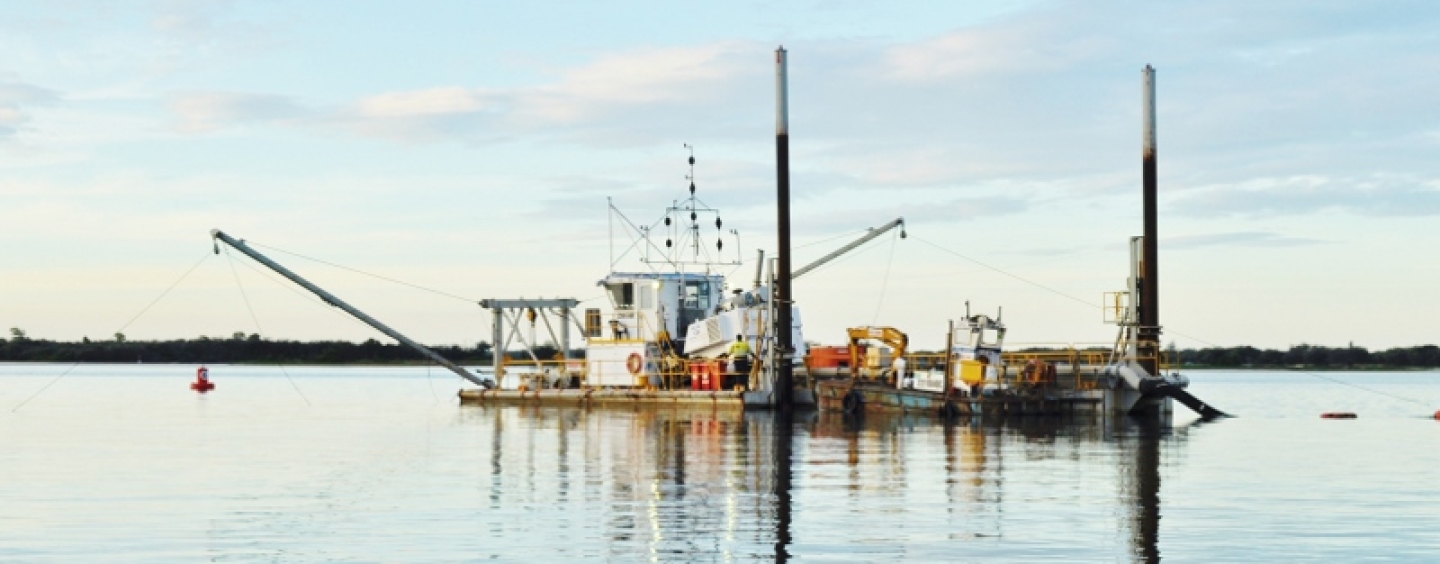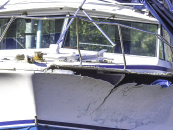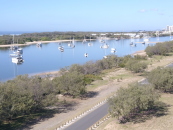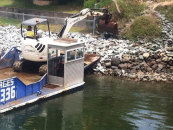The Gold Coast is undoubtedly one of Australia’s unique and most liveable cities, with more than 300 sunny days per year. It can be even called as ‘The City of Canals’, since extensive navigable waterways are stretching around the city.
There is a significant and rapid increase that can be observed in recreational boating activity on these waterways and the maintenance of these channels is essential to provide a safe and enjoyable access for boaties. One of the most important segments of maintenance is dredging, carried out by the City of Gold Coast and the Gold Coast Waterways Authority (GCWA).
Dredging is an excavation activity of moving underwater material such as sand or other sediment types to a different location. By doing so, waterways channels and harbours can be artificially deepened and widened. This technique involves using machinery to address a variety of issues including navigation safety, flood mitigation, legislative requirements to maintain canals, and foreshore nourishment.
The process of dredging ensures that the Gold Coast waterways are navigable for craft. Channels easily become narrow or too shallow to navigate as a result of build-up of sediment, and tidal and weather conditions. Dredging also has significant benefits in flood prevention. By increasing the channel depth, the channel’s capacity for carrying water increases.
As more than 90 percent of the sediment collected from navigation dredging is natural and undisturbed, the deposits can be used to create and restore habitats. This can also assist in offsetting the effects of erosion which is a significant problem on the Gold Coast.
Types of Dredging
There are three types of dredging conducted on the Gold Coast. The most common type is called the ‘cutter suction dredge’ that relies on a stationary vessel, with a cutter head that is moved across the bottom, sucking up sand and then delivering it through a pipeline, typically to an adjacent foreshore. “The cutter suction dredge is the most common, reflecting its advantages for the dredging needs that are typical for our local waterways,” explains Brian McRae, strategy manager at GCWA.
The second type is called the ‘trailer suction hopper dredge’, where the vessel movement is responsible for translating the suction arm along the bottom, and the material goes into the hold of the ship. This type of dredge can shuttle the dredged material to a relatively longer distance and can be used in open ocean environments where ‘cutter suction dredge’ cannot operate. It cannot easily deliver the material to shore in the way that ‘cutter suction dredge’ can, but offshore nourishment can be as effective and there are other ways to get the material directly to the shore.
The third type of dredge is usually a ‘bucket’ or ‘grab’ dredge that can be very useful when the water’s bottom consists of hard material, such as gravel.
Economic benefits
“The City of Gold Coast and the GCWA have jointly produced a document called the Sand Management Plan for Gold Coast Waterways that provides a plan to holistically manage sand resources, addressing both navigational access and foreshore management,” shares McRae.
“A clear principle of the Sand Management Plan is to maximise the benefits by coordinating channel and foreshore maintenance needs,” expounds McRae. “Sand management—dredging and nourishment—are a key component of the management of our waterways to support resident, visitor and industry use and enjoyment of the estuarine environment that lies between the hinterland and the ocean beaches.”
The economic benefits of dredging depend on the purpose of dredging. “Dredging may include a flood mitigation purpose, legislative responsibilities together with visual amenity, and erosion prevention purposes,” according to the City of Gold Coast spokesperson.
Inevitably, significant processes such as dredging activities do cost money. That is the price that has to be paid to live in a built environment and altered natural systems. It is also important to note that marine environment presents challenges in terms of both logistics—working underwater—and environmental management.
“The good news is that prudent management can address all three issues—defray cost, simplify logistics, and mitigate environmental concerns—and that’s another key objective of the Sand Management Plan,” explains McRae.
Direct effects from dredging, indirect effects associated with sediment plumes and management of the dredged material can have impacts on the environment. The City spokesperson says, “All dredging approvals provided by State Authorities come with strict environmental conditions that must be complied with the dredging operator. These strict conditions ensure that minimal impact to the environment occurs.”
“In the case of dredging the navigation channel, GCWA seeks to follow, rather than fight nature, realigning the marked channel to mirror migration of the natural channel. This reduces the need for dredging, and therefore the cost as well,” adds McRae.
Regarding the environmental assessments for dredging, the City of Gold Coast and GCWA have partnered with regulatory agencies under the Sand Management Plan to create an Environmental Management Framework that facilitates consideration of the entire ecosystem.
“Historically, each dredging project was assessed in isolation. An Agency Steering Committee has been established to coordinate project-level approvals. A Scientific Advisory Committee has also been created to progress strategic initiatives, such as the recent marine plant survey—the first such waterways-wide effort to characterise this important ecosystem on the Gold Coast,” says McRae.
City-wide dredging activities
“Nourishing adjacent foreshores is a preferred strategy under the Sand Management Plan, as provides recreational amenity, is a sustainable option of protecting foreshore infrastructure such as storm drains and revetment, and by minimising transport distances, it also reduces the expense of dredging,” states McRae.
Although nourishing foreshores is a preferred option to utilise dredged material, it is not always a viable option. Dredging the Broadwater, Coomera River, Tallebudgera and Currumbin Creeks requires different approaches of dredging. Foreshore nourishment is the preferred choice of managing dredged material at the Broadwater, where marine sand is characterised as good and clean. However, it is challenging to the northern region where the nourishment is prohibited because of the extensive Broadwater-Jumpinpin fish habitat area. McRae says that nourishment can potentially be used to enhance long-term habitat outcomes. “It isn’t necessarily detrimental, but we need to progress the scientific investigations to improve our understanding of the options.”
The Coomera River has marine sands on the lower end, but very fine material, such as silt content, further upstream requiring a land-based management option under current environmental regulations. “Planning has been underway for some time for a regional solution and GCWA is now progressing approvals for a permanent rehandling facility in the Coomera Marine Precinct,” affirms McRae.
Dredging activities at Tallebudgera and Currumbin Creeks address flood problems and enhance ocean beaches. According to the City spokesperson, “In conjunction with managing the maintenance dredging of artificial waterways, the City also completes annual dredging campaigns of Currumbin and Tallebudgera Creek for flood mitigation purposes and to assist with the nourishment of adjacent ocean beach profiles. The City has also undertaken historical dredging works to re-establish beach profiles after periods of heavy erosion.”
These activities provide navigational access benefits for boaties. However, the key potential navigational hazard is that the dredging footprint does not address shoaling near the entrances. “GCWA recognises this issue and supports education about the hazards of coastal bar crossing, but maintains the view that dredging is not a feasible solution in the highly active coastal environment. The Sand Bypass System was designed and built specifically as an alternative to the problems associated with dredging coastal entrances,” declares McRae.
Canal dredging
Numerous waterfront properties can be found around the Gold Coast, and the City is regularly carrying out the dredging on a three-year cycle to pump sand back up against the retaining and revetment walls, if necessary. A healthy canal profile provides a stable foreshore with the benefit of an acceptable visual amenity. The City of Gold Coast is also responsible to monitor and maintain artificial waterways, such as canals and lakes as close to their original design as possible under the Coastal Protection Management Act of 1995.
“Presently within the Gold Coast City, there is in excess of 600 kilometres of waterfront properties, 220 kilometres comprised of lake or canal frontage and 400 kilometres of public and private revetment walls. The responsibility for private revetment walls rest with the respective property owner. Waterfront property owners are encouraged to seek professional engineering advice on the structural adequacy of their revetment wall and whether any maintenance or structural works are required to maintain it,” advises the City spokesperson.
Dredging is vital to social and economic development. Boating activities on the Gold Coast are booming at the moment. Eleven percent of Queensland’s recreational boats are located here, and according to the latest data, there are more than 28,000 recreational boats and almost 700 commercial vessels registered on the Gold Coast. Dredging of our waterways is an essential element of maintenance to keep these waterways safe.
By Patrick Molnar






























